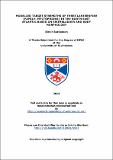Files in this item
Modelled target strengths of three lanternfish (family: Myctophidae) in the north east Atlantic based on swimbladder and body morphology
Item metadata
| dc.contributor.advisor | Brierley, Andrew | |
| dc.contributor.author | Bardarson, Birkir | |
| dc.coverage.spatial | 97 | en_US |
| dc.date.accessioned | 2015-04-30T14:24:33Z | |
| dc.date.available | 2015-04-30T14:24:33Z | |
| dc.date.issued | 2014-08 | |
| dc.identifier.uri | https://hdl.handle.net/10023/6607 | |
| dc.description.abstract | At mesopelagic depths (200-1000 m), in the oceanic parts of the earth, there are probably the most abundant fish assemblages in the world, often observed on echosounder displays as sound scattering layers extending over vast areas. Lanternfish are believed to be an important part of those layers. In recent years, acoustic backscatter has been used successfully to quantify pelagic fish stocks, where knowledge of individual fish backscatter proportion, the target strength, is essential for reliable estimate. More knowledge on target strength of the lanternfish found in the Northeast Atlantic is needed before they can be properly identified and quantified by acoustics. Air in the swimbladder will cause much stronger backscatter than the fish body. In this study, external morphology and swimbladder morphology of three abundant lanternfish species (Benthosema glaciale, Notoscopelus kroeyerii and Myctophum punctatum) were measured using digital imaging and soft x-ray technology to inform theoretical acoustic target strength (TS) models. The soft x-ray measurements indicated that 71% by number of the adult B. glaciale population (sample size (n) = 85) had an air filled swimbladder, while N. kroeyrii (n = 127) and M. punctatum (n = 99) did not have inflated swimbladders in their adult stage. A distorted wave Born approximation (DWBA) model was used to estimate TS contribution of the fish body while a prolate spheroid resonance scattering model was used for contribution of swimbladder. Further, a comparison was made with exact solution models. At 38 kHz, the commonly used frequency in scientific surveys, N. kroeyri was estimated with the TS length relationship of 22.6 log(SL) – 92.8 while M. punctatum had 10.9 log(SL) – 81.5. At same frequency the mean TS of B. glaciale was estimated as -64.29 dB with 95% confidence limits of -65.52 and -63.33 dB. Further the TS estimates and scattering properties of all three species were estimated at different frequencies (18, 38, 70, 120 and 200 kHz). These multifrequency TS data will assist with acoustic identification and biomass estimation of lanternfish that, in turn, will enable contribution of much-needed lanternfish data to ecosystem models. | en_US |
| dc.language.iso | en | en_US |
| dc.publisher | University of St Andrews | |
| dc.subject | Target strength | en_US |
| dc.subject | Acoustic | en_US |
| dc.subject | Swimbladder | en_US |
| dc.subject | Prolate spheroid model | en_US |
| dc.subject | Distorted wave born approximation model | en_US |
| dc.subject | Lanternfish | en_US |
| dc.subject | Mesopelagic fish | en_US |
| dc.subject | Northeast Atlantic | en_US |
| dc.subject | Myctophid | en_US |
| dc.subject | Benthosema glaciale | en_US |
| dc.subject | Notoscopelus kroeyerii | en_US |
| dc.subject | Myctophum punctatum | en_US |
| dc.subject.lcc | QL638.M9B2 | |
| dc.subject.lcsh | Lanternfishes | en_US |
| dc.subject.lcsh | Air-bladder (in fishes) | en_US |
| dc.subject.lcsh | Sonar | en_US |
| dc.subject.lcsh | North Atlantic Ocean | en_US |
| dc.title | Modelled target strengths of three lanternfish (family: Myctophidae) in the north east Atlantic based on swimbladder and body morphology | en_US |
| dc.type | Thesis | en_US |
| dc.type.qualificationlevel | Doctoral | en_US |
| dc.type.qualificationname | MPhil Master of Philosophy | en_US |
| dc.publisher.institution | The University of St Andrews | en_US |
This item appears in the following Collection(s)
Items in the St Andrews Research Repository are protected by copyright, with all rights reserved, unless otherwise indicated.

